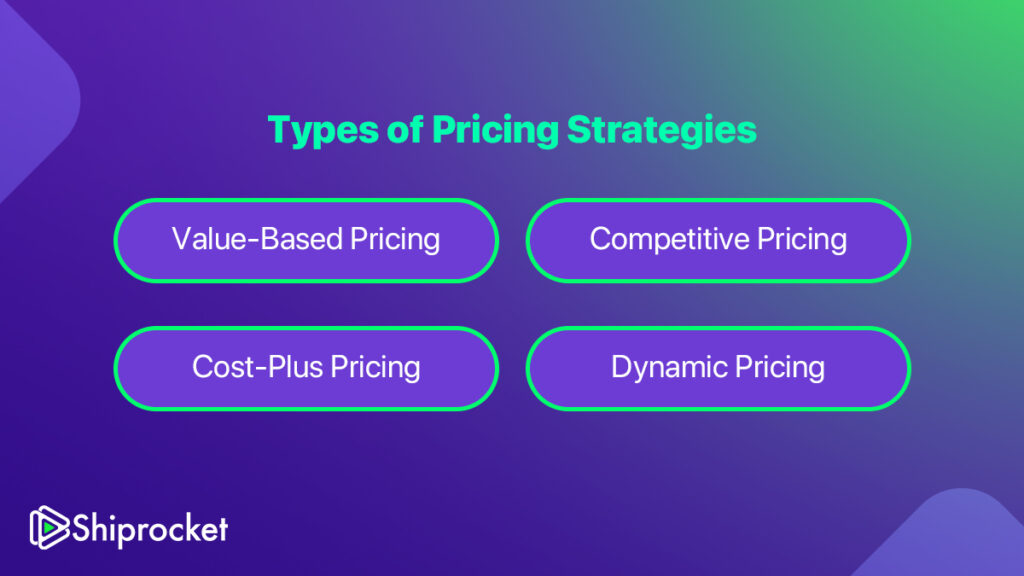Pricing Strategies: Common Types and Usage
“If you’ve got the power to raise prices without losing business to a competitor, you’ve got a very good business.”
-Warren Buffett
Pricing puts your branding, reputation, and, ultimately, your profits at stake. Whether you run an offline business or an online store, your prices must always make sense to your prospects. If you don’t get your pricing strategy right, you might actually have to pay the price.

Almost 34% of shoppers compare prices on their mobile devices even while in a physical store, which tells you enough about how crucial pricing is for your business. However, setting the correct prices for your products is never really a walk in the park.
Set them too high, and lose valuable sales. Set them too low, and sacrifice revenue. How do you balance the scales? Fortunately, some pricing strategies and models might come in handy.

Types of Pricing Strategies
Pricing strategies are essentially the processes and methodologies you could use to determine the amount you would charge for a product. There are four common kinds of pricing strategies that you can adopt depending on your target audience and your revenue goals.
- Value-based pricing
- Competitive pricing
- Cost-plus pricing
- Dynamic pricing
Value-Based Pricing Strategy
This strategy relies on the principle that value is more expensive than the price. For your end consumer, price is what they give, and value is what they get in return. This value is what your consumer believes it to be, what they think your product is worth. You set your prices according to this perceived value.
While determining this so-called value might look like a tough nut to crack, things get easier once you start collecting customer feedback at regular intervals. Moreover, this might be one of the most effective pricing strategies in today’s customer-centric market, especially for businesses with unique value propositions.
Competitive Pricing Strategy
It’s always nice to have good competition, you know. It pushes you to do better. If you’re just starting, setting your prices based on what you’re competition is charging might do the trick. You can price your products slightly below, the same as, or slightly above your competition.
For instance, if you’re selling shipping software and your competitor’s monthly plan ranges from INR 1500 to INR 3000, you’d want to set a price between these two numbers.
But hold on, there’s a catch. Your prospects are probably not just looking for the lowest prices but the best value at the lowest prices. There’s a significant difference between the two.
It’s not necessarily about competing on the prices. It’s rather about being a flamingo in a flock of pigeons; it’s about setting your business apart from the competition. You need to offer something your competition doesn’t.
Providing excellent customer service, a friction-free return policy, or lucrative loyalty benefits can help put your brand in a better position to gain and maintain an edge over your competitors. Now, on top of it, if you’re pricing your products competitively enough, you’re already dressing for success.
Cost-Plus Pricing Strategy
What’s the basic idea behind any business? You make something and sell it for more than you spent making it; plain and simple. It makes the cost-plus strategy the most straightforward of all pricing strategies.
All you’ve got to do is just take the production cost of your product and add a fixed percentage (markup) to it, representing the value you’ve added.
Suppose you’ve just started an online apparel store and need to calculate a shirt’s selling price. Let’s say the costs incurred are:
Material costs= INR 200
Labor costs= INR 400
Overhead costs= INR 300
The total cost here comes out to be INR 1000. If your markup is 40%, you can easily calculate the selling price using the following formula:
Selling price= INR 1000(1 + 0.40)
By this logic, the selling price for your shirt would be INR 1400. Easy, isn’t it? While this strategy covers all your costs and predictably ensures consistent profits, it doesn’t consider market conditions and could be inefficient sometimes.
Dynamic Pricing Strategy
It’s a relatively flexible pricing strategy where you can adjust prices in real time based on market and customer demand. The idea is to capitalise on the changing market and sell the same product at different prices to different people.
You must have seen hotels, airlines, event venues, or an eCommerce store adopt and nail this strategy. For example, an eCommerce store would often adjust its prices based on market price, seasons, competitors, or even the launch of a new collection, for that matter.
You will find this effective if you run a business of that kind. Step into the shoes of a consumer. You might not get as good as someone else. Do you think this is fair? Let us know.
Which of the Pricing Strategies Is Perfect for You?
If you’re on the fence thinking about which one out of these pricing strategies fits your business the best, here’s a tip. Consider combining two or more methods to determine the correct product pricing.
In any case, it’s more than essential to sit down and determine what exactly you charge for, define your buyer persona and segments, and carry out extensive market research before setting the prices. Good things take time; give it enough of it.





